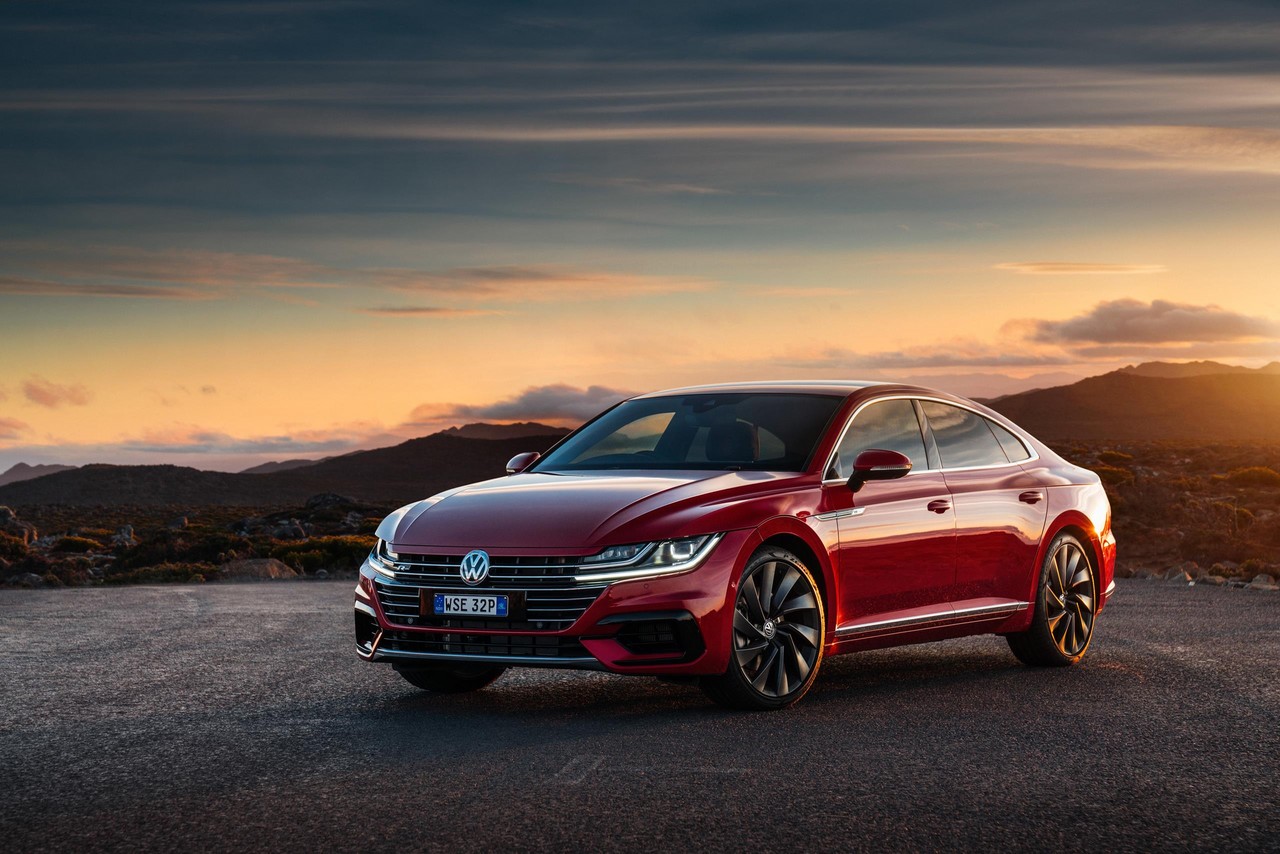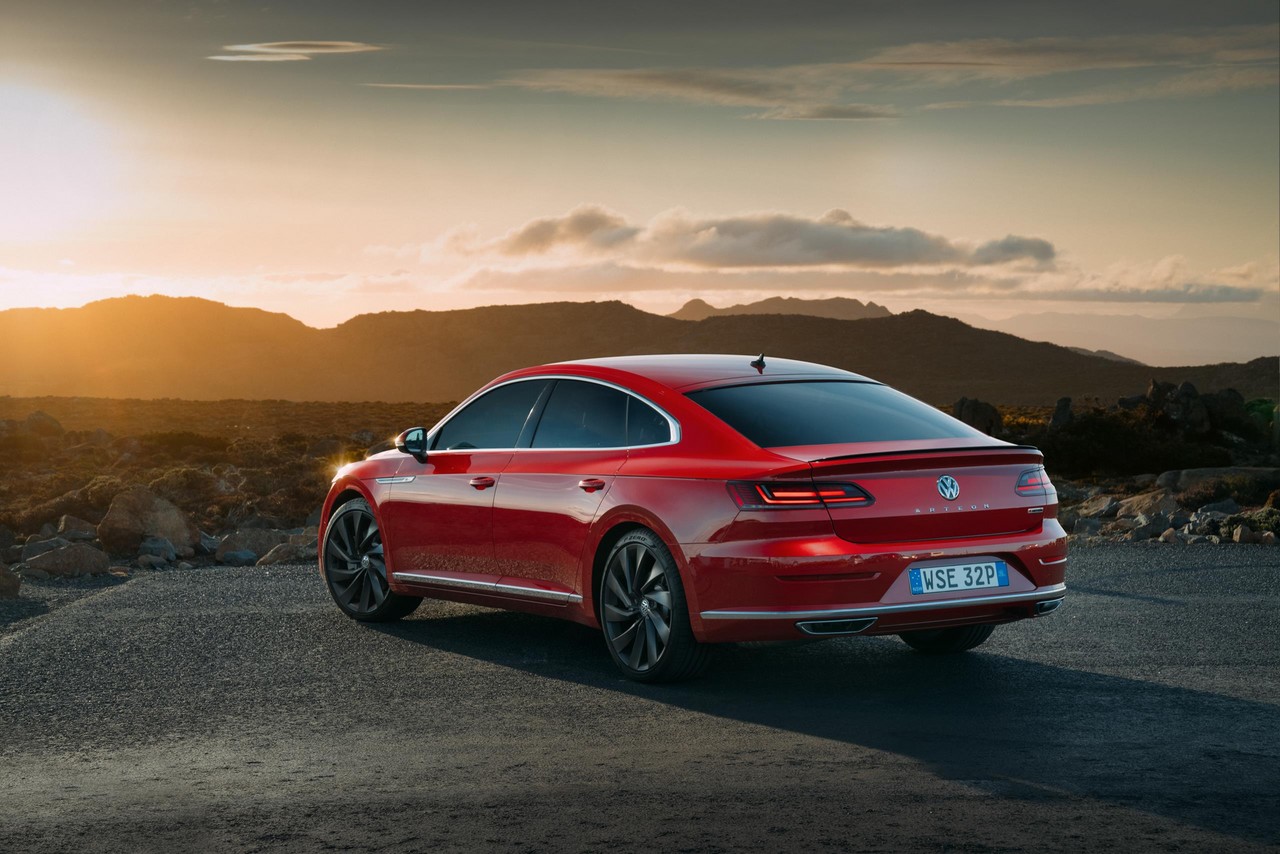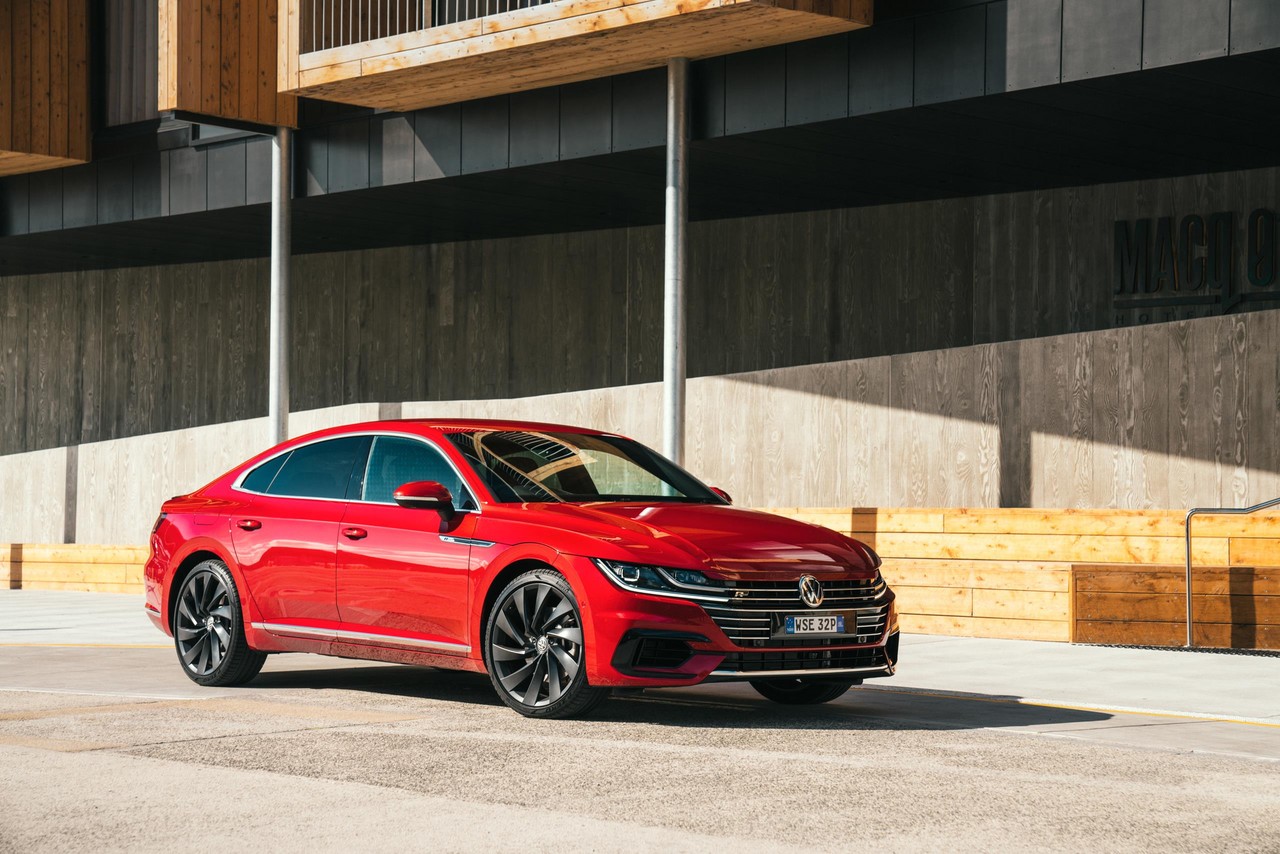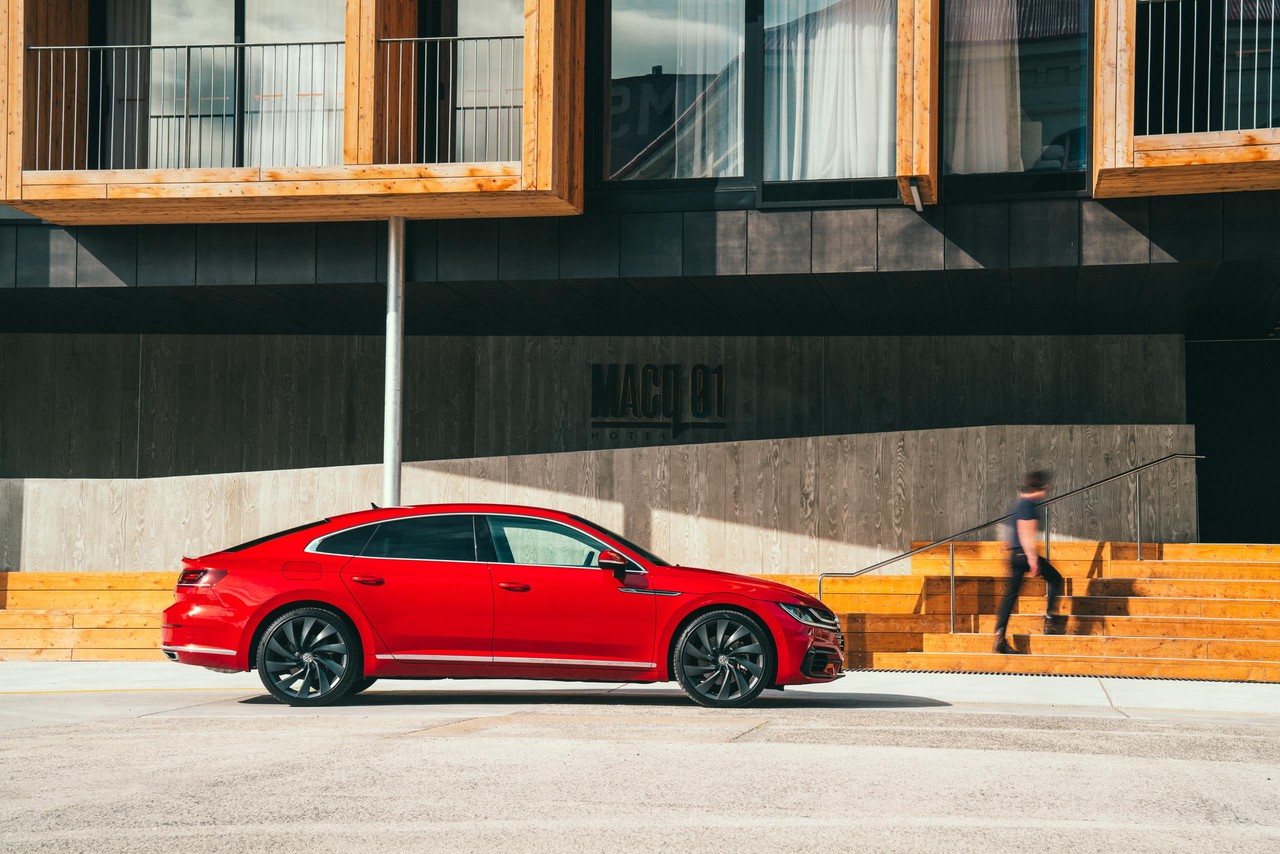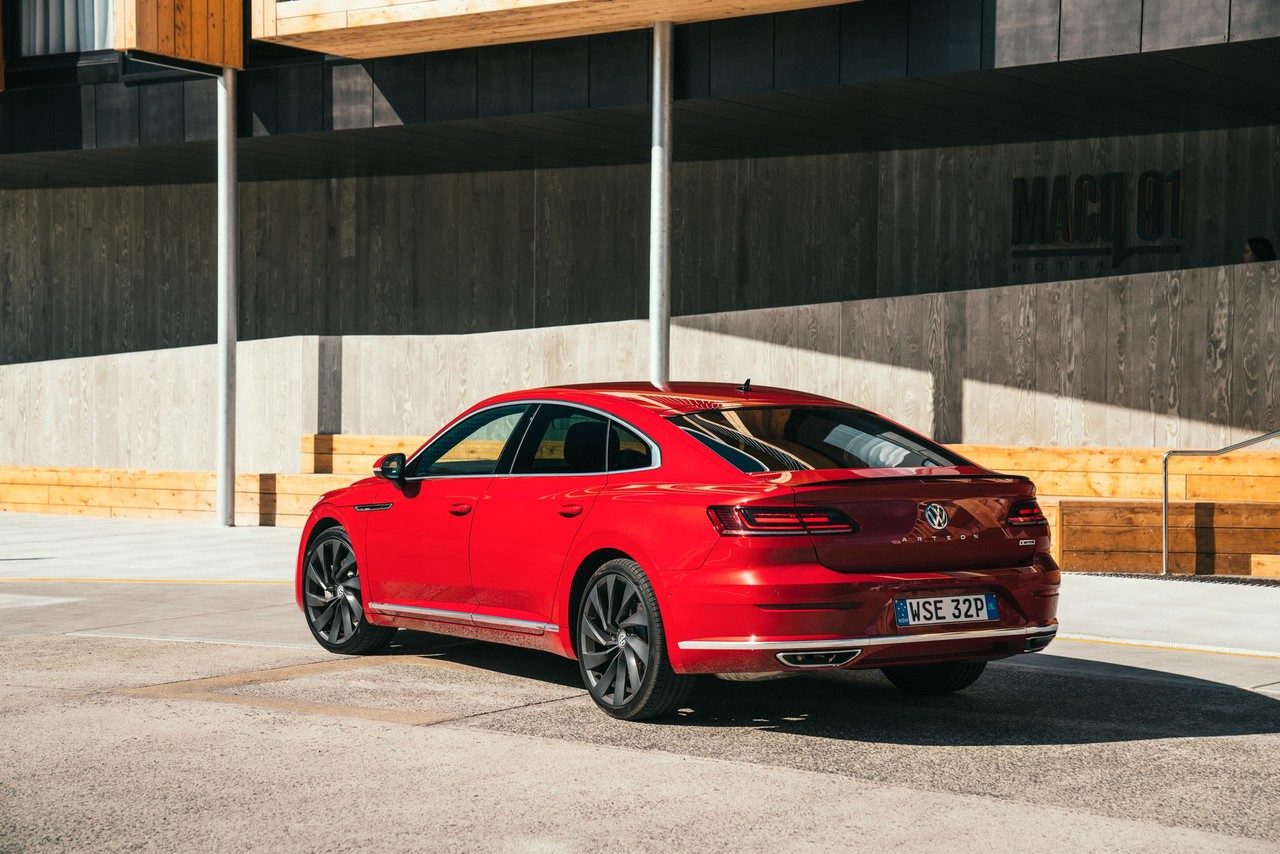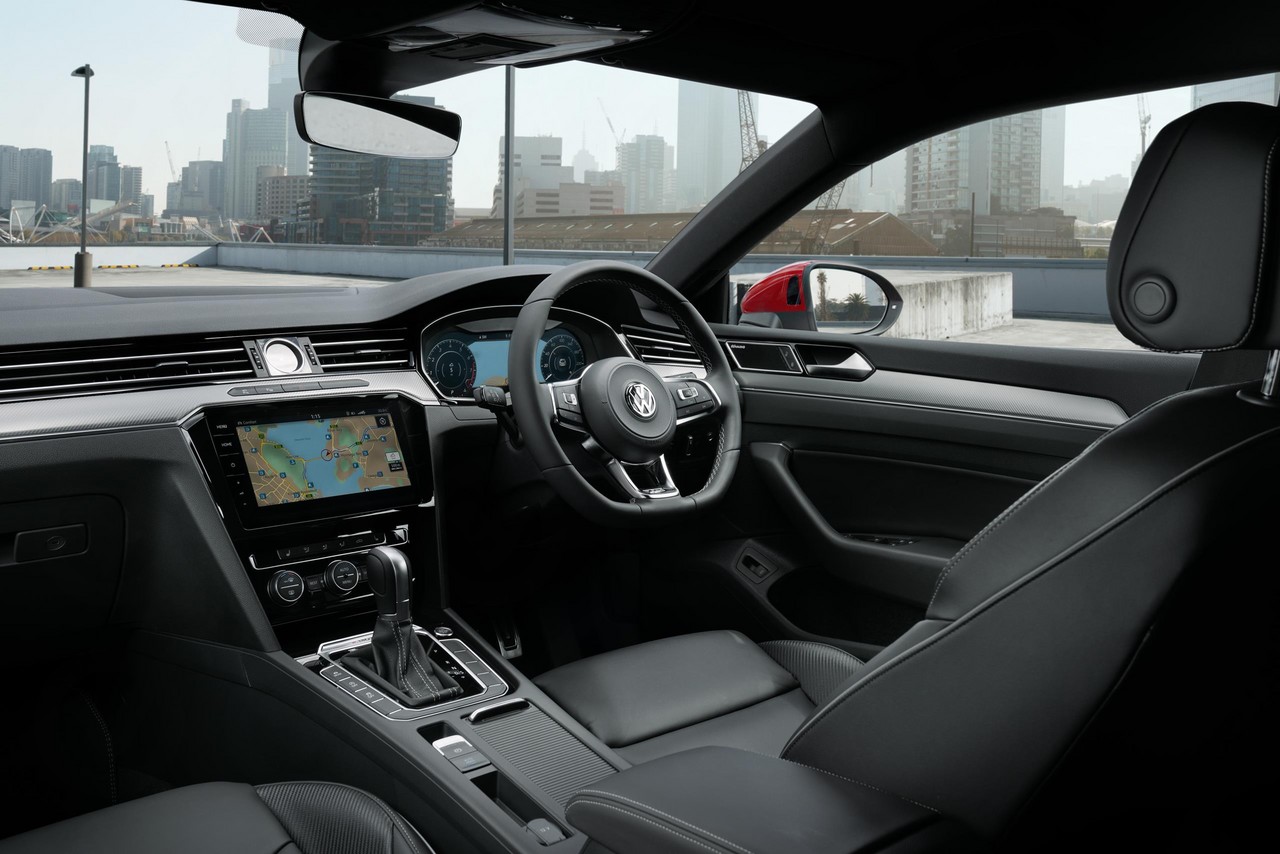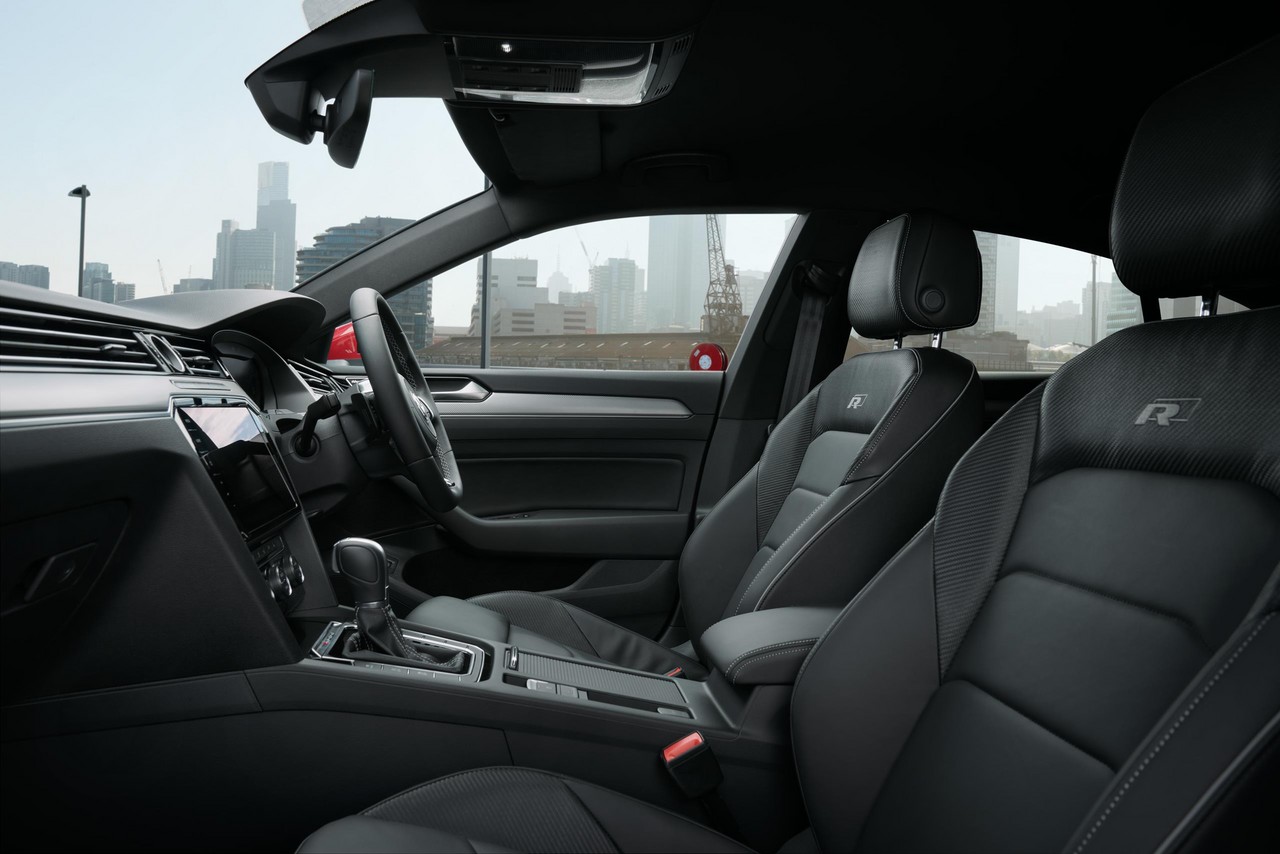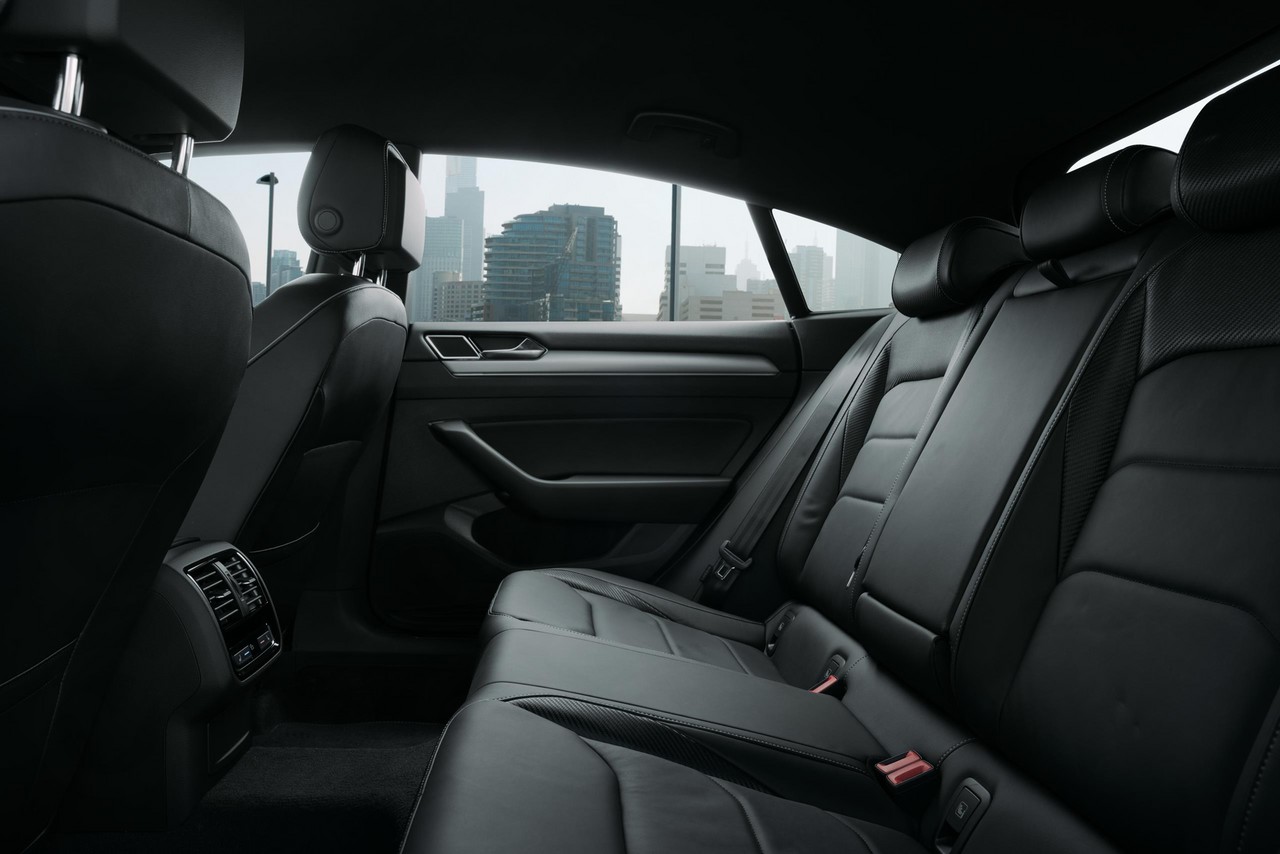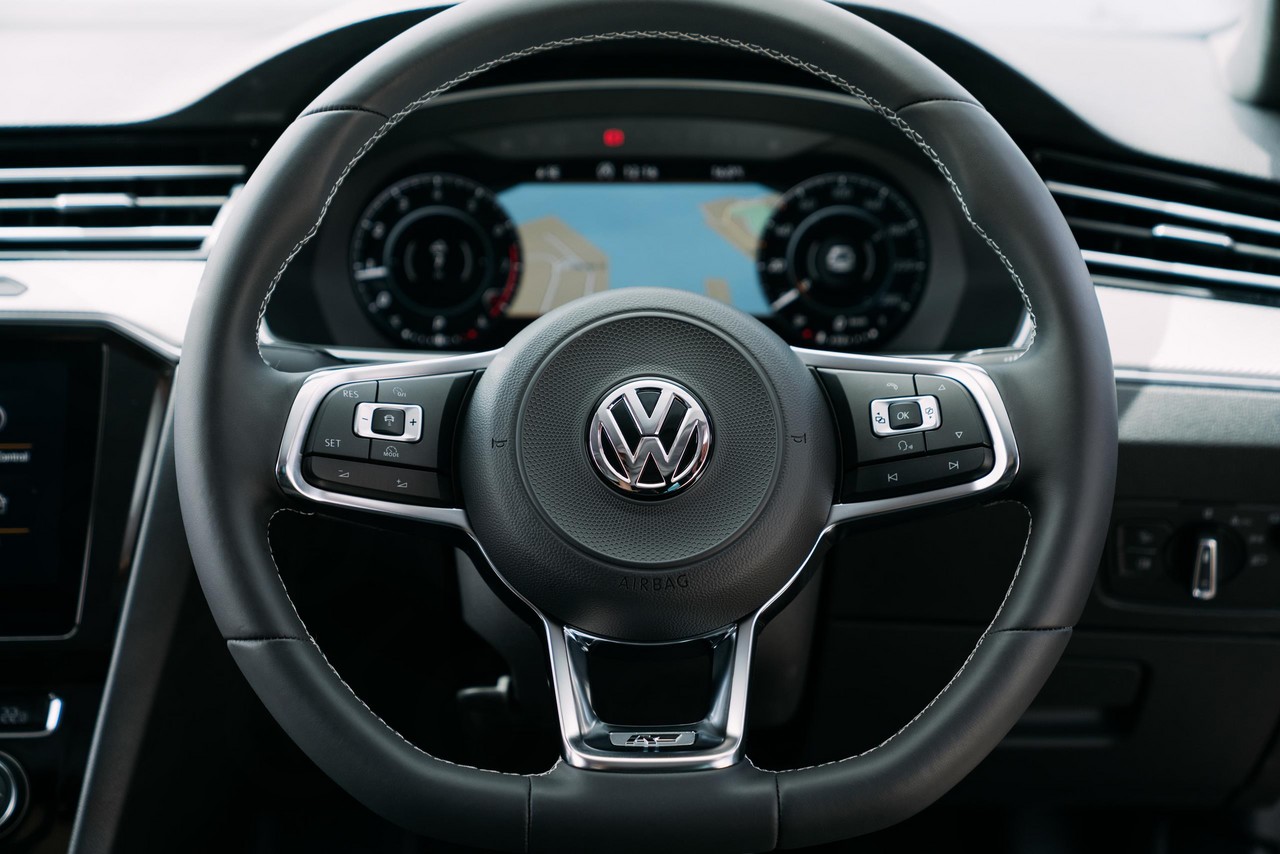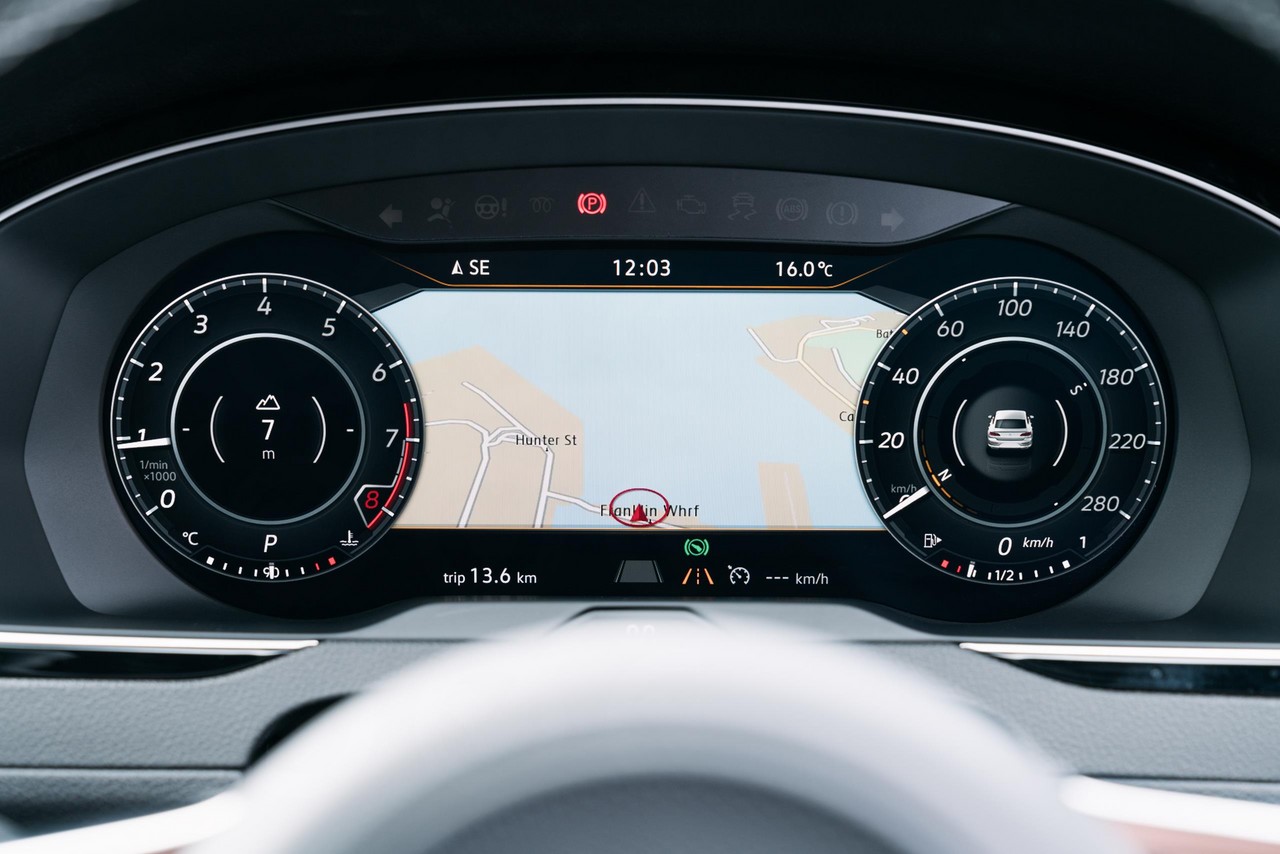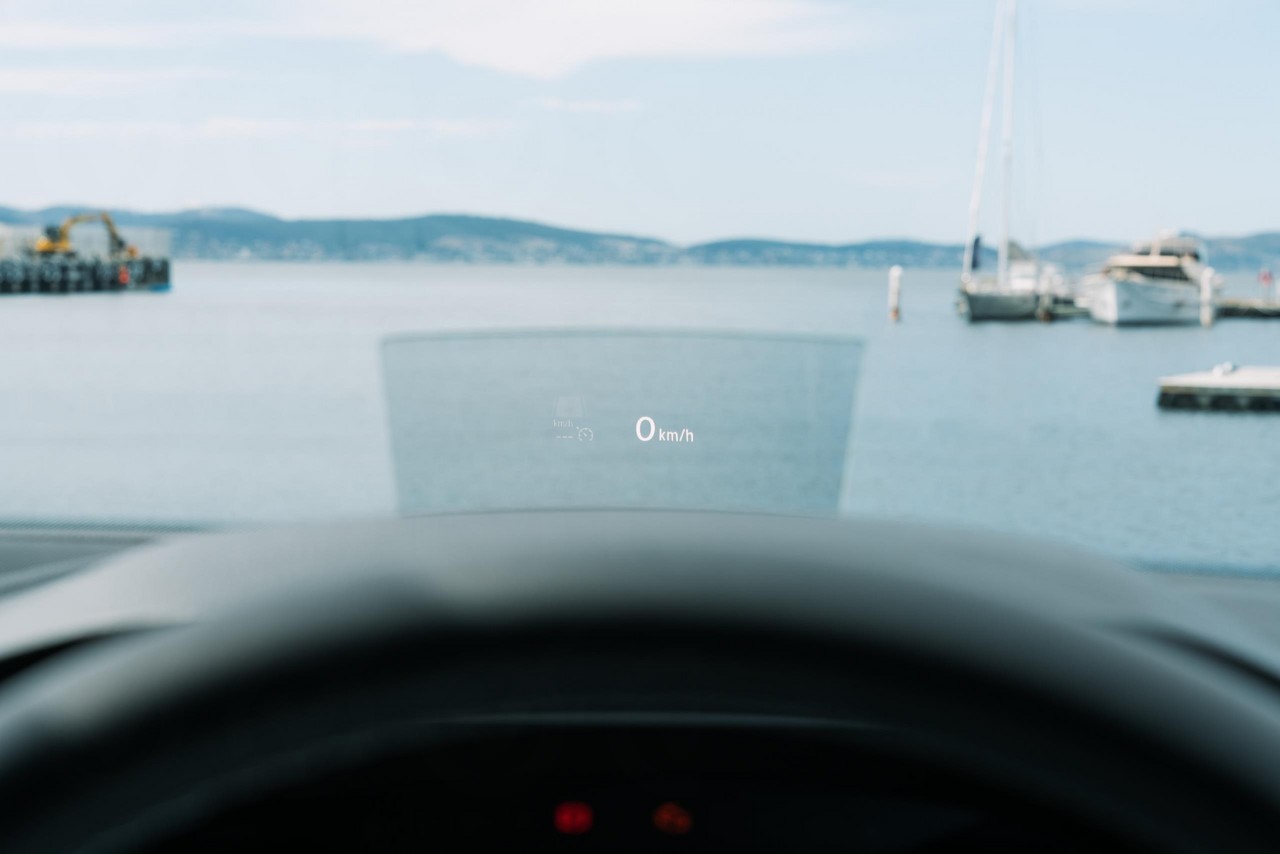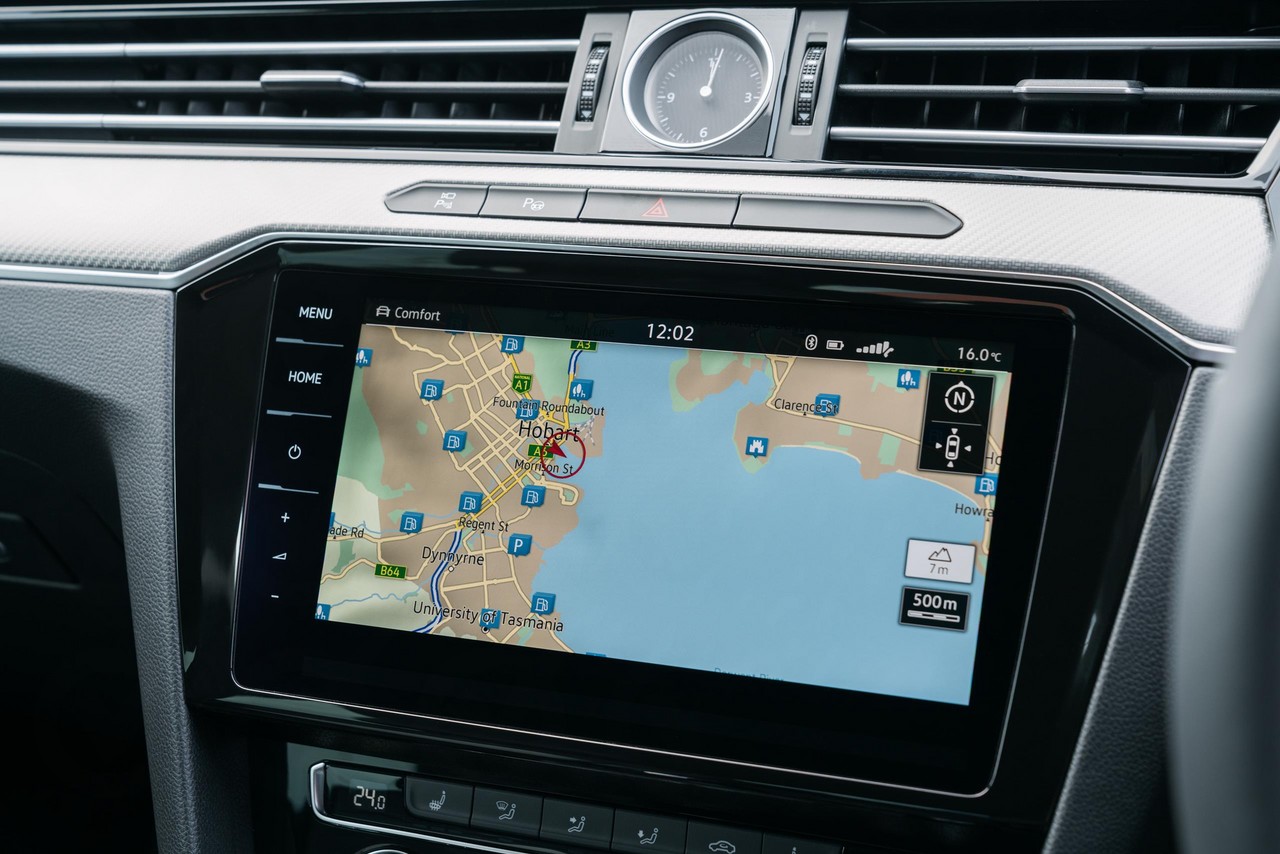
- Responsive 2.0-litre DJHC turbo petrol engine
- All-wheel drive traction
- Five star Euro NCAP safety rating
- Well-weighted steering and competent dynamics
- Spacious interior and boot
- On 19-inch wheels and 245/40 tyres, bump absorption is poor
- Not as engaging to drive as rear-wheel drive rivals
- Greater in-cabin road noise than rivals
- Not worth its price premium to the related B8 Passat
Overview
Released in Australia in October 2017, the Volkswagen Arteon was a four-door fastback with a top-hinged tailgate. Manufactured in Emden, Germany, the all-wheel drive Volkswagen Arteon 206TSI was be powered by a 2.0-litre turbocharged petrol engine that was mated to a seven-speed double clutch transmission (Volkswagen’s ‘DSG’). For Australia, the Arteon 206TSI was solely available as an R-Line edition and had a recommended retail price of $65,490 upon its release.
To reduce fuel consumption, the Volkswagen Arteon 206TSI had:
- An ‘automatic start-stop’ function which could shut down the engine when the vehicle was stationary in traffic; and,
- A ‘brake energy recuperation’ system which used an ‘intelligent’ alternator that increased its output during braking and coasting phases and temporarily stored this energy in the battery so that it could be used to power the vehicle’s on-board electrical system when the driver next accelerated.
Over the combined ADR 81/02 test cycle, fuel consumption for the Arteon 206TSI was 7.5 litres per 100 km. Furthermore, the Volkswagen Arteon 206TSI could accelerate from rest to 100 km/h in 5.6 seconds.
| Variant | Engine | Trans. | Peak power | Peak torque |
|---|---|---|---|---|
| 206TSI 4MOTION R-Line | 1984 cc DJHC turbo petrol I4 | 7sp DCT (DQ381) |
206 kW at 5100-6500 rpm | 350 Nm at 1700-6500 rpm |
Haldex V all-wheel drive system
The Volkswagen Arteon had a Haldex V all-wheel drive system (Volkswagen’s ‘4MOTION’). The Haldex V system consisted of an electronically controlled and hydraulically actuated multi-plate clutch coupling that was located in front of the rear axle differential (at the end of the prop shaft). Under low loads or when coasting, the rear axle was decoupled to reduce fuel consumption. If, however, there was a loss of front wheel traction or such a loss was anticipated by on-board sensors, then an electro-hydraulic oil pump applied pressure to the clutch plates to transfer up to 50 per cent of the engine’s torque to the rear wheels (for a 50:50 front:rear torque split).
The Volkswagen Arteon was also fitted with an ‘Extended Electronic Differential Lock’ (Volkswagen’s ‘XDL’). When cornering, the XDL responded to the unloading of the front inside wheel by applying the brakes to that wheel to prevent wheelspin and minimise understeer.
Body and dimensions
The Volkswagen Arteon was underpinned by Volkswagen’s Modular Transverse Matrix (MQB) which was shared with the B8 Passat. Compared to the Volkswagen B8 Passat , the Arteon was 95 mm longer (at 4862 mm), 39 mm wider (1871 mm), 21 mm lower (1435 mm) and had a 46 mm longer wheelbase (2837 mm). Furthermore, the luggage compartment of the Arteon had a volume of 563 litres.
The Volkswagen Arteon 206TSI had a tare mass of 1716 kg.
Suspension and steering
The Volkswagen Arteon had MacPherson strut front suspension and independent, four-link rear suspension. As standard, the Arteon was equipped with Volkswagen’s ‘Adaptive Chassis Control’ which consisted of electronically controlled dampers that continually adjusted to driving conditions.
The Volkswagen Arteon had rack-and-pinion steering with electric power assistance that varied according to vehicle speed; its turning circle was 11.7 metres. For the Arteon R-Line, the steering had progressive ratios that varied with speed; as such, a higher ratio meant that fewer turns were required for low-speed manoeuvres, while a lower ratio provided greater control at higher speeds. A ‘Driving Profile Selection’ function also enabled the driver to choose from five drive modes – Eco, Sport, Normal, Comfort and Individual – which adjusted steering assistance, throttle response and transmission programming.
Safety equipment
Standard safety equipment for the Volkswagen Arteon included dual front airbags, a driver’s knee airbag, front and rear side airbags, full-length curtain airbags, ABS, electronic brake force distribution, brake assist, electronic stability control, traction control, driver fatigue monitoring, post-collision braking, front seatbelts with pre-tensioners and load limiters, and outer rear seatbelt pre-tensioners.
As standard, the Volkswagen Arteon was equipped with the following active safety technologies –
- Front Assist: used a radar sensor to detect if the vehicle was closing too fast on the vehicle ahead. If this occurred, Front Assist 1) provided audible and visual warnings to the driver, 2) brought the brake pads into contact with the brake discs for an emergency stop; and, 3) provided a jolting brake application to alert the driver. If the driver failed to respond, Front Assist would apply the brakes automatically to avoid or reduce the severity a collision;
- City Emergency Brake: an extension of Front Assist, City Emergency Braking operated at speeds up to 65 km/h and used a radar sensor and front camera to monitor the area ahead for vehicles and pedestrians. If a collision was anticipated, the driver was alerted via visual and audible warnings, followed by jolting brake application. If the driver failed to respond, the system would initiate emergency braking;
- Adaptive Cruise Control (ACC): using a radar sensor, ACC could apply the vehicle’s brakes to reduce vehicle speed and maintain a pre-set distance to vehicle ahead. ACC could also cause the vehicle to accelerate back to its cruising speed when the road ahead cleared;
- Traffic Jam Assist: used Adaptive Cruise Control (ACC) to provide automatic braking and accelerating in the stop-and-go speed range and the Lane Assist function to keep the Arteon in the middle of its lane;
- Emergency Assist 2: if a lack of steering activity indicated that the driver was inactive or incapacitated while Adaptive Cruise Control and Lane Assist were engaged, Emergency Assist 2 would alert the driver with an intermittent gong, brake and steering jolts. Furthermore, Emergency Assist 2 used Side Assist (described below) to safely change lanes by indicating and moving to the far left lane or emergency lane (depending on traffic and road conditions) and would bring the vehicle to rest;
- Lane Assist (lane departure warning): using a camera to recognise lane markings, Lane Assist could detect unintentional lane drifting or changing and provide corrective steering actions for up to eight seconds. If the corrective steering actions were insufficient, the driver would be warned via steering wheel vibrations;
- Side Assist (lane change assistant): operated at speeds of 10 km/h and used two radar sensors in the rear bumper to monitor the area up to 70 metres behind the vehicle. If a vehicle was detected approaching from the rear or alongside the Arteon, the driver was warned by illumination of an LED in the door mirror housing. If the driver then activated the turn indicator in the direction of the detected vehicle, the Side Assist indicator flashed to draw the driver’s attention to the mirror. If the driver attempted to steer into that area, the Lane Assist system would provide a counter-steering action to prevent the lane change;
- Rear Traffic Alert: when the driver was attempting to reverse out of a parking space, Rear Traffic Alert used radar sensors in the rear bumper to detect traffic up to 50 metres away that may cross the vehicle’s intended path. If a collision risk was detected, Rear Traffic Alert would provide a visual warning, followed by an audible warning. If the driver did not respond to the warnings and there was an immediate collision risk, Rear Traffic Alert would automatically apply the brakes;
- Proactive occupant protection system: used the rear radar sensors to anticipate rear-end collisions. If there was a collision risk, the hazard warning lights would display the emergency collision alert signal and the Arteon would prepare for an impact by closing all windows (except for a narrow gap that improved the bracing effect of the front head airbags), closing the sliding sunroof (where fitted) and using the belt tensioners to tighten the front seatbelts;
- Manoeuvre braking: when reversing at speeds up to 10 km/h, ‘Manoeuvre braking’ could initiate emergency braking if a collision risk was detected;
- Driver Fatigue Detection: operating at speeds over 65 km/h, Driver Fatigue Detection monitored steering wheel movements for signs of fatigue. If detected, the driver would receive a warning in the multi-function display and an acoustic signal. The warning would be repeated after 15 minutes if the driver had not taken a break; and,
- Multi-collision brake: after a collision, multi-collision brake would automatically apply the brakes for controlled deceleration to reduce vehicle speed and the likelihood of a second collision.
The Volkswagen Arteon also had an ‘active bonnet’ which, in the event of a frontal collision at speeds between 25 km/h and 55 km/h, would deploy pyrotechnic charges to raise the height of the bonnet to provide additional deformation space over ‘hard points’ in the engine bay.
Euro NCAP testing
In Euro NCAP testing , the Volkswagen Arteon received a five star safety rating which included a 96 per cent adult occupant protection rating and an 85 per cent child occupant protection rating. In the frontal offset test, driver protection was generally rated as good, though protection of the lower left leg was rated as adequate (i.e. a slight risk of serious injury). While maximum points were awarded in the side impact test, chest protection in the more severe pole test was rated as adequate.
Wheels, tyres and brakes
The Volkswagen Arteon 206TSI R-Line had 8.0J x 19-inch ‘Montevideo’ alloy wheels with 245/40 R19 ‘AirStop’ tyres, 340 mm by 30 mm ventilated front brake discs and 310 mm by 22 mm ventilated rear discs.
Features: Volkswagen Arteon 206TSI R-Line
The infotainment system for the Volkswagen Arteon R-Line consisted of Volkswagen’s ‘Discover Pro’ infotainment system with a 9.2-inch colour touch screen, satellite navigation system with 2D and 3D maps, two SD card slots, an eight speaker sound system, CD player, MP3/WMA/AAC compatibility, a 3.5 mm auxiliary input, two USB ports, 10 GB internal storage, Bluetooth mobile phone connectivity and audio streaming, App-Connect USB interface for smartphone integration (Apple CarPlay, Android Auto and Mirror Link) and voice control.
Byeond this, the Volkswagen Arteon R-Line featured Nappa leather upholstery with R-Line logos, an ‘ergoComfort’ driver’s seat, fourteen-way power adjustable front seats, individually heated front and outer rear seats, three-zone climate control air conditioning, a chillable and lockable glovebox, cruise control, a rear fog lamp, a head-up display (HUD), rain-sensing wipers, a leather-wrapped ‘R-Line’ steering wheel, 60/40 split and folding rear seats with load-through provision, remote central locking with proximity key (i.e. keyless entry), power adjustable and heated door mirrors with folding function, power windows, tilt and telescopic steering wheel adjustment, height adjustable front seats, an auto-dimming rear view mirror, push-button start, 12 volt power sockets (centre console and rear seat area), driver memory settings (for the front seats and door mirrors), LED ambient lighting, illuminated vanity mirrors, a ‘Titan Black’ roof liner, aluminium pedals, stainless steel door tread plates, floor mats, heated windscreen washer jets, rear privacy glass, tyre pressure monitoring, a trip computer, an alarm and immobiliser.
As standard, the Volkswagen Arteon 206TSI was also equipped with:
- LED headlights (high and low beam) that had dynamic cornering lights and integrated LED daytime running lights. Furthermore, the LED headlights had dusk-sensing and automatic high beam functions (Volkswagen’s ‘Dynamic Light Assist’);
- Volkswagen’s ‘Active Info Display,’ a 12.3 inch high-resolution TFT display in place of the standard instrument cluster;
- Volkswagen’s ‘Optical Parking System’ or OPS which consisted of parking sensors (front and rear) and a rear view camera with static guidelines and distance to obstacles;
- ‘Park Assist’ which could detect parallel and right angle parking spaces and provide automated steering for the parking manoeuvre while the driver controlled vehicle speed;
- A 360-degree ‘Area View’ function which utilised four cameras – in the bootlid, both door mirrors and radiator grille – to provide obstacle detection and a 3D bird’s eye view of the vehicle. From the Display menu, the driver could select the camera views (front, rear, side or bird’s eye view) with either a full or split screen; and,
- ‘Easy Open and Close’ function for hands-free operation of the liftback.
Visual cues for the Volkswagen Arteon R-Line included its R-Line bumpers, high-gloss black front air intakes, chrome trim strip for the lower bodywork and chrome-plated exhaust tailpipes.
Options: Volkswagen Arteon
Options for the Australian-delivered Volkswagen Arteon included 20-inch ‘Rosario’ alloy wheels with 245/35 R20 ‘AirStop’ tyres, a 700 watt Dynaudio premium sound system with ten speakers and a sixteen-channel digital amplifier, a panoramic glass sunroof and metallic or pearl effect paint finishes.
Specifications
Related links
